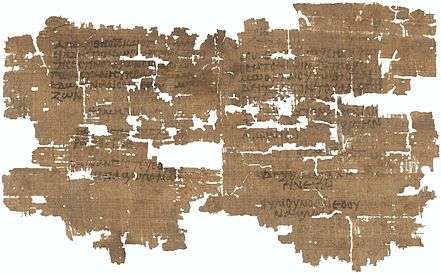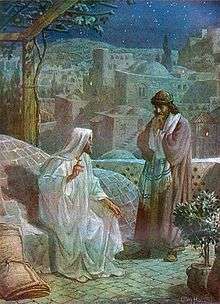John 3
John 3 is the third chapter of the Gospel of John in the New Testament of the Christian Bible. Baptist preacher Charles Spurgeon said of this chapter that it is the chapter he would choose "to read to a dying man who did not know the gospel, [as] the most suitable one for such an occasion".[1]
| John 3 | |
|---|---|
 John 3:14-18 on the recto side in Papyrus 63 (c. AD 500) | |
| Book | Gospel of John |
| Category | Gospel |
| Christian Bible part | New Testament |
| Order in the Christian part | 4 |
Text
The original text was written in Koine Greek. This chapter is divided into 36 verses.
Textual witnesses
Some early manuscripts containing the text of this chapter are:
- Papyrus 75 (AD 175-225)
- Papyrus 66 (c. 200)
- Codex Vaticanus (325-350)
- Codex Sinaiticus (330-360)
- Codex Bezae (c. 400; extant verses 27-36)
- Codex Alexandrinus (400-440)
- Codex Ephraemi Rescriptus (c. 450; extant verses 34-36)
- Papyrus 63 (c. 500; extant verses 14-18)[2]
Nicodemus

The first part of the chapter begins with Nicodemus, said to be a member of the ruling council, coming at night to talk with Jesus, whom he calls Rabbi. On account of Jesus' "miraculous signs", Nicodemus and others ("we" in John 3:2) have recognized that Jesus is " a teacher come from God". It is not clear for whom Nicodemus speaks – the translation in The Voice adds wording, "Teacher, some of us have been talking ..." – but many commentators infer from the nighttime setting for this meeting that Nicodemus came alone, privately, "through shame, and fear of his brethren of the council",[3] shame possibly arising because, "being a master in Israel, [he would not want] to be looked upon as a scholar going to learn of another".[4] Methodist writer Joseph Benson notes, with support, theologian Daniel Whitby's interpretation, that "the Pharisees and rulers knew Christ to be a teacher come from God".[3]
In reply Jesus declared, "I tell you the truth, no one can see the kingdom of God unless he is born from above, or born again." The word in Greek: ἄνωθεν may be translated as either "again" or "from above". The King James Version, the English Standard Version and the New International Version all say "born again", whereas the New Revised Standard Version and Young's Literal Translation both have "born from above" in their text with an alternative note "born anew".[5] Nicodemus's reply, "How can someone be born when they are old? Surely they cannot enter a second time into their mother's womb to be born!"[6] reflects an understanding that Jesus is speaking of a second birth. Nicodemus understands the double entendre literally, whereas Jesus has in mind the figurative sense of ἄνωθεν (born “from above”).[7] Jesus then talks of what it means to be born again and the path to heaven. "I tell you the truth, no one can enter the kingdom of God unless he is born of water and the Spirit. Flesh gives birth to flesh, but the Spirit gives birth to spirit." (5-6)
Verse 7
Marvel not that I said unto thee, Ye must be born again.[8]
This verse gives emphasis to 'the imperative character of the new birth', with 'nothing optional about it'.[9]
Verse 14
And as Moses lifted up the serpent in the wilderness, even so must the Son of man be lifted up:[10]
Verse 16
For God so loved the world, that he gave his only begotten Son, that whosoever believeth in him should not perish, but have everlasting life.[11]
This chapter is intended to show the importance of the belief in Jesus as the son of God. Jesus is shown here already proclaiming himself the Messiah and laying out aspects of Christian theology, in contrast to Mark for instance, where Jesus seems to try to keep the fact of his divinity secret until his final trip to Jerusalem.
Nicodemus appears here, in chapter 7:50 and is listed in John 19:39, and only in John, as helping Joseph of Arimathea to bury Jesus.
Jesus baptizes
In the second part of the chapter, Jesus goes with his disciples into the land of Judea, the region round about Jerusalem,[12] presumably towards the River Jordan,[13] and remains there and baptizes.[14] John the Baptist is also baptizing people nearby, at Aenon, near Salim. John's disciples tell John that Jesus is also baptizing people, more than John it seems (John 3:26: "everybody is going to Him"). John replies that "A man can receive only what is given him from heaven. You yourselves can testify that I said, 'I am not the Christ, but am sent ahead of him.' The bride belongs to the bridegroom. The friend who attends the bridegroom waits and listens for him, and is full of joy when he hears the bridegroom's voice. That joy is mine, and it is now complete. He must become greater; I must become less." He finishes by saying "Whoever believes in the Son has eternal life, but whoever rejects the Son will not see life, for God's wrath remains on him." This passage is meant to show John's acceptance of Jesus's superiority as well as a further emphasis on belief in him as the path to eternal life/heaven.
There is a group still surviving today, the Mandaeans, who claim John as the greatest prophet.[15]
Use of verses from John 3
Biblical references for verses John 3:7 and John 3:16 are both used in signage and popular culture to communicate the message of the Christian gospel.
See also
References
- Charles Spurgeon in the sermon Jesus Christ's Idiom, quoted by David Guzik in Guzik Bible Commentary on John 3, accessed 12 February 2016
- Aland, Kurt; Aland, Barbara (1995). The Text of the New Testament: An Introduction to the Critical Editions and to the Theory and Practice of Modern Textual Criticism. Erroll F. Rhodes (trans.). Grand Rapids: William B. Eerdmans Publishing Company. p. 100. ISBN 978-0-8028-4098-1.
- Joseph Benson, Benson Commentary on John 3, accessed 11 February 2016
- Matthew Poole's Commentary on John 3, accessed 11 February 2016
- All variants taken from BibleGateway.com
- John 3:4
- James L. Resseguie, "A Glossary of New Testament Narrative Criticism with Illustrations," in Religions, 10 (3: 217), 11.
- John 3:7 KJV
- Guthrie 1994, p. 1031.
- John 3:14 KJV
- John 3:16 KJV
- Barnes, A., Barnes' Notes on John 3, accessed 3 May 2019
- Meyer, H., Meyer's NT Commentary on John 3, accessed 3 May 2017
- John 3:22
- "The Mandaeans: True descendents of ancient Babylonians". Nineveh.com. Retrieved 2011-12-17.
Sources
- Guthrie, Donald (1994). "John". In Carson, D. A.; France, R. T.; Motyer, J. A.; Wenham, G. J. (eds.). New Bible Commentary: 21st Century Edition (4, illustrated, reprint, revised ed.). Inter-Varsity Press. pp. 1021–1065. ISBN 9780851106489.
Further reading
- Brown, Raymond E., An Introduction to the New Testament Doubleday 1997 ISBN 0-385-24767-2
- John 3 NIV
External links
- John 3 King James Bible - Wikisource
- English Translation with Parallel Latin Vulgate
- Online Bible at GospelHall.org (ESV, KJV, Darby, American Standard Version, Bible in Basic English)
- Multiple bible versions at Bible Gateway (NKJV, NIV, NRSV etc.)
| Wikimedia Commons has media related to Gospel of John - Chapter 3. |
| Preceded by John 2 |
Chapters of the Bible Gospel of John |
Succeeded by John 4 |